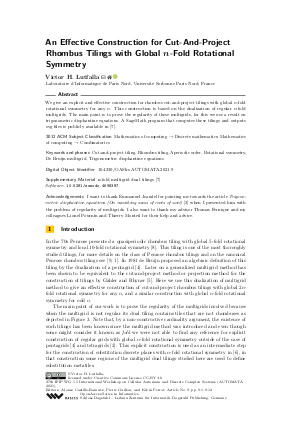An Effective Construction for Cut-And-Project Rhombus Tilings with Global n-Fold Rotational Symmetry
Author
Victor H. Lutfalla 
-
Part of:
Volume:
27th IFIP WG 1.5 International Workshop on Cellular Automata and Discrete Complex Systems (AUTOMATA 2021)
Part of: Series: Open Access Series in Informatics (OASIcs)
Part of: Conference: International Workshop on Cellular Automata and Discrete Complex Systems (AUTOMATA) - License:
 Creative Commons Attribution 4.0 International license
Creative Commons Attribution 4.0 International license
- Publication Date: 2021-06-28
File

PDF
OASIcs.AUTOMATA.2021.9.pdf
- Filesize: 0.76 MB
- 12 pages
Document Identifiers
Subject Classification
ACM Subject Classification
- Mathematics of computing → Discrete mathematics
- Mathematics of computing → Combinatorics
Keywords
- Cut-and-project tiling
- Rhombus tiling
- Aperiodic order
- Rotational symmetry
- De Bruijn multigrid
- Trigonometric diophantine equations
Metrics
- Access Statistics
-
Total Accesses (updated on a weekly basis)
0PDF Downloads0Metadata Views
Abstract
We give an explicit and effective construction for rhombus cut-and-project tilings with global n-fold rotational symmetry for any n. This construction is based on the dualization of regular n-fold multigrids. The main point is to prove the regularity of these multigrids, for this we use a result on trigonometric diophantine equations. A SageMath program that computes these tilings and outputs svg files is publicly available in [Lutfalla, 2021].
Cite As Get BibTex
Victor H. Lutfalla. An Effective Construction for Cut-And-Project Rhombus Tilings with Global n-Fold Rotational Symmetry. In 27th IFIP WG 1.5 International Workshop on Cellular Automata and Discrete Complex Systems (AUTOMATA 2021). Open Access Series in Informatics (OASIcs), Volume 90, pp. 9:1-9:12, Schloss Dagstuhl – Leibniz-Zentrum für Informatik (2021)
https://doi.org/10.4230/OASIcs.AUTOMATA.2021.9
BibTex
@InProceedings{lutfalla:OASIcs.AUTOMATA.2021.9,
author = {Lutfalla, Victor H.},
title = {{An Effective Construction for Cut-And-Project Rhombus Tilings with Global n-Fold Rotational Symmetry}},
booktitle = {27th IFIP WG 1.5 International Workshop on Cellular Automata and Discrete Complex Systems (AUTOMATA 2021)},
pages = {9:1--9:12},
series = {Open Access Series in Informatics (OASIcs)},
ISBN = {978-3-95977-189-4},
ISSN = {2190-6807},
year = {2021},
volume = {90},
editor = {Castillo-Ramirez, Alonso and Guillon, Pierre and Perrot, K\'{e}vin},
publisher = {Schloss Dagstuhl -- Leibniz-Zentrum f{\"u}r Informatik},
address = {Dagstuhl, Germany},
URL = {https://drops.dagstuhl.de/entities/document/10.4230/OASIcs.AUTOMATA.2021.9},
URN = {urn:nbn:de:0030-drops-140182},
doi = {10.4230/OASIcs.AUTOMATA.2021.9},
annote = {Keywords: Cut-and-project tiling, Rhombus tiling, Aperiodic order, Rotational symmetry, De Bruijn multigrid, Trigonometric diophantine equations}
}
Author Details
Acknowledgements
I want to thank Emmanuel Jeandel for pointing me towards the article Trigonometric diophantine equations (On vanishing sums of roots of unit) [Conway and Jones, 1976] when I presented him with the problem of regularity of multigrids. I also want to thank my advisor Thomas Fernique and my colleagues Lionel Pournin and Thierry Monteil for their help and advice.
Supplementary Materials
- n-fold multigrid dual tilings [Lutfalla, 2021]
- Software https://doi.org/10.5281/zenodo.4698387
References
- M. Baake and U. Grimm. Aperiodic Order: A Mathematical Invitation, volume 1. Cambridge University Press, 2013. URL: https://doi.org/10.1017/9781139033862.
-
F.P.M. Beenker. Algebraic theory of non-periodic tilings of the plane by two simple building blocks : a square and a rhombus, 1982. Technical report.

- J. Conway and A. Jones. Trigonometric diophantine equations (on vanishing sums of roots of unity). Acta Arithmetica, 30(3):229-240, 1976. URL: https://doi.org/10.4064/aa-30-3-229-240.
- N. G. De Bruijn. Algebraic theory of penrose’s nonperiodic tilings of the plane. i and ii. Kon. Nederl. Akad. Wetensch. Proc. Ser. A, 43(84):39-66, 1981. URL: https://doi.org/10.1016/1385-7258(81)90016-0.
- F. Gähler and J. Rhyner. Equivalence of the generalised grid and projection methods for the construction of quasiperiodic tilings. Journal of Physics A: Mathematical and General, 19(2):267, 1986. URL: https://doi.org/10.1088/0305-4470/19/2/020.
- J. Kari and V. H. Lutfalla. Substitution planar tilings with n-fold rotational symmetry, 2020. URL: http://arxiv.org/abs/2010.01879.
- V. H. Lutfalla. n-fold multigrid dual tilings, 2021. Software repository. URL: https://doi.org/10.5281/zenodo.4698387.
-
R. Penrose. The role of aesthetics in pure and applied mathematical research. Bull. Inst. Math. Appl., 10:266-271, 1974.

-
M. Senechal. Quasicrystals and geometry. CUP Archive, 1996.

